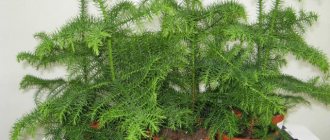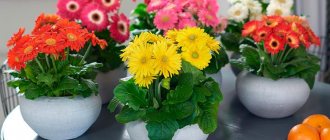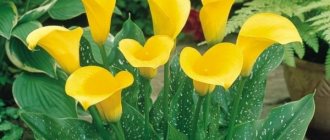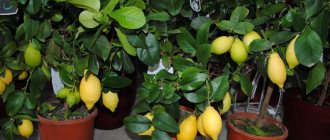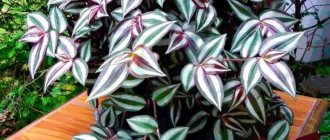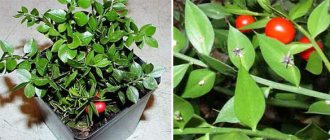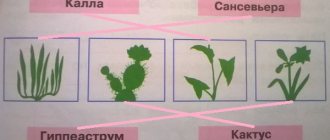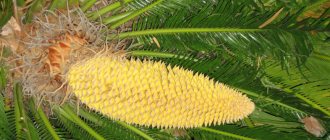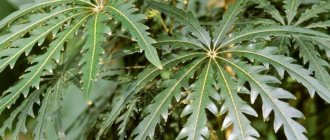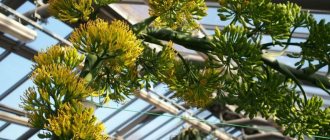Climbing indoor plants: an ideal solution for interior decoration
Climbing indoor plants are an excellent option for decorating a room. With their help, you can create an original design for both a living space and a work office. These “green residents” are able to enliven the dark corners of the room and bring it spaciousness and a cozy atmosphere. In this material we will look at the names and varieties of the most popular and unpretentious climbing plants for indoor landscaping, and the description and photo will help you make your choice.
Decorative deciduous vines
Climbing flowers, unlike others, have a variety of shapes and colors. Representatives of the flora are light purple, dark green, plain and variegated, oval and pointed.
Scindapsus
It does not require much effort or time and grows in almost any habitat. This houseplant has bright green leaves with light spots and a heart-shaped shape. Scindapsus grows beautifully, forming new shoots. They can entangle the support or simply hang down. The liana needs periodic pinching, from which lush shoots are formed.
- To feed this “green resident”, fertilizers must be diluted 2 times weaker than written in the instructions;
- In indoor conditions, the flower grows slowly for the first year, but after this time it grows at a rapid pace;
- During active growth, room temperature has a beneficial effect on it, but in winter the plant must be placed in a cool place.
Indoor birch (or cissus)
This liana is very unpretentious and quite famous; it is closely related to the grapevine. Its emerald leaves are pink on the inside and sometimes have silver inclusions. Long shoots are attached to the protrusions with tendrils and entwine the supports.
If such a flower is properly cared for, it will quickly grow and delight you with its beauty. We wrote in detail about caring for cissus in this article.
Growing conditions:
- Easily tolerates heat and cold;
- Loves bright light, but also grows in the shade;
- Birch prefers spraying and does not respond well to heavy watering.
Answers to frequently asked questions
- How to water ivy? In the warm season, it is necessary to water it 2-3 times a week. Under no circumstances should the soil be allowed to dry out excessively, as this will negatively affect the growth of hedera.
- A couple of tricks that can help a gardener when propagating ivy. If you replant it and after 7-10 days no new shoots have appeared, it may not have enough minerals and fertilizers to grow productively. In this case, it makes sense to change the soil, which will be more rich in nutrients. The size of the piece of plant from which a new one will then appear should vary from 10 to 20 cm. Thanks to this, the root system of the hedera will receive an acceptable amount of micronutrients, which will allow the buds to bloom and give the loach new life.
In general, ivy is a very unpretentious plant that does not require excessive care. For its successful growth and development, it is necessary to provide an optimal level of fertilizing, heat and humidity, with the help of which the hedera will grow. The loach is quite suitable for use for decorating a particular room due to its appearance, which makes it similar to a liana.
Climbing decorative foliage flowers with large leaves
Philodendron climbing
It has bright green, glossy, heart-shaped leaves that reach 10 cm or more in length. The leaves of the “green resident” are arranged “in turns” on creeping, thin stems. The tops of the flower are pinched, the shoots are tied to some kind of support - this makes this climbing indoor plant with leaves become bushy. Some types of philodendron are similar to scindapsus, in contrast to which there are no light stripes on the leaves of this vine, and the young leaf blades have a reddish underside.
- It is necessary to fertilize with complex fertilizers during the growth period;
- The plant is grown at home in a well-lit room, excluding exposure to sunlight;
- Try to keep the substrate moist. Its surface should dry out a little in winter.
Syngonium
It is an indoor vine, which at the beginning of growth has variegated, bright, large arrow-shaped leaves. With age, they change and become blade-like. Such climbing house flowers have aerial roots on their stems, which need to be supported using a moss stick.
There are several varieties of syngonium: vines with white or green leaves and variegated types. At home it reaches one and a half meters in height.
Features of growing at home:
- Individuals with variegated leaves are best placed in places with abundant lighting, excluding direct sunlight;
- Frequent watering and daily misting are required, otherwise dry conditions will cause the foliage to yellow and dry out.
Description of Hoya, reality and myths
Hoya belongs to the leafy plants, consisting of climbing vines and subshrubs. The plant received the name Hoya after the gardener Hoy, who was the first to master the care of exotic plants in Europe. Hoya is a liana-shaped plant, the length of the rapidly growing stem reaches 10 meters. Hoya wax ivy is the most common type of home propagation. It has fleshy, shiny leaves and aerial roots form on the stems. At first the vines are docile and soft, but then they become woody and have difficulty changing shape.
When the hoya blooms, it should not be rearranged or turned over. The unapproachable beauty will drop its buds and there will be no flowering this summer.
In addition to beautiful leaves, hoya produces ivy flowers at home. Fragrant single stars are collected in baskets of balls. Hoya blooms for a long time even at home. The fast-growing, unpretentious vine has become a favorite decoration of official institutions. However, there is still no definite answer as to whether it is possible to keep Hoya wax ivy at home.
Mystical properties have long been attributed to many plants. Superstition is associated with old friends, beautiful plants - Chinese roses, cacti, hanging plants. Among them there is also indoor ivy, which can entwine other plants and deprive them of light. But in this case, the blame for the excessively overgrown vines lies with the grower. Indoor flowers create comfort and absorb harmful substances. Many of the poisonous plants on the windowsill have medicinal properties.
Hoya wax ivy is considered to bring bad luck. The main one is that the flower drives husbands and sons out of the house, according to one version. The family may suffer misfortunes and financial well-being. Another says the flower pacifies envy, the plant of family happiness. Is it possible to keep a Hoya wax ivy flower at home? Learn from your own experience. The only obstacle may be an allergy to pollen in one of the family members.
If the flower is regularly sprayed and wiped with a damp cloth, the Hoya will not be colonized by insect pests. The leaves will look fresh. Dust settles quickly on a glossy surface, clogging the pores.
In fact, this beautiful hanging crop is absolutely harmless. It does not suppress the growth of other flowers. But if you give free rein and do not monitor the plant, the vine will penetrate into any crevice. Therefore, the vines need to be guided along special stands. The photo shows whether it is possible to keep wax ivy at home in a given format, and how to create guides for the vine.
Climbing flowering plants
Blooming vines create a picturesque view and a cozy atmosphere in the house. They are used to decorate shelves, whatnots, and window sills.
Tradescantia
Climbing indoor plants include this popular vine in their ranks, which grows in literally every home. Tradescantia has short-lived white flowers and soft, hairy leaves with a silver tint. With flowers and leaves of purple color you can only find Tradescantia silomantan.
- You should not allow excess nitrogen in fertilizing, which leads to weakening of the leaves;
- The liana responds well to abundant watering from spring to autumn, but if the soil is too wet, the leaves and trunk may begin to rot;
- It grows well in well-lit places.
Morning glory tricolor
In the house it grows as a perennial plant, and in the garden as an annual plant. A huge number of green leaves and attractive blue gramophone flowers make this vine very recognizable. A thin stem with evenly spaced flowers needs to be tied to different supports. Dry buds are constantly removed so that the morning glory blooms longer.
Features in cultivation:
- The plant feels good in a cool room in winter;
- It needs to be watered regularly and abundantly, and the soil should not be allowed to dry out;
- It is recommended to grow the liana in a lighted place, but at the same time shade it from direct sunlight.
How to care for indoor climbing plants: general recommendations
Almost all types of such “green residents” are undemanding to frequent care. But they need to be looked after differently than regular flowers. Here are some tips:
- Plants should be positioned so that their foliage does not come into contact with each other. These representatives of the flora prefer a low level of illumination, so they should be installed in corners or dark places;
- Climbing species love moisture, so they need to be watered regularly. Also, do not forget about spraying with a spray bottle. This will make the bush more luxuriant and reduce drying of the leaves;
- In winter, climbing plants need to be watered less. But it is necessary to monitor the condition of the soil and prevent it from drying out;
- To prevent water from spilling onto the floor, before watering the flower, put a rubber cap on the flowerpot and remove it after about an hour, when all the moisture has been absorbed;
- You can water in a different way. Place an ice cube on the surface of the soil in the pot. It will gradually melt and saturate the ground with moisture;
- Tea bags placed around the perimeter of the tray will help absorb excess water when watering.
Proper care of indoor climbing plants will help you grow a beautiful green vertical garden indoors, which will not only create a cozy homely atmosphere, but will also purify the air.
Caring for climbing house flowers
Each type of vine has its own care requirements, but there are some general principles. For example, to the ground. Climbing plants belong either to the plants of the lower tier of forests or to ground cover. The first ones look for support to stretch up, the second ones crawl freely along the ground or hang down. Ground covers are not particularly demanding on the soil.
Other vines love fertile soil with a high content of the following substances:
- humus,
- nutrients,
- drainage materials that provide looseness.
It is useful to cover the soil with mulch. It will slow down the evaporation of moisture after watering.
Important. Ground covers love nutritious substrate. If you don’t know how flowers grow in natural conditions, feel free to choose fertilized soil.
Watering
Lianas need moisture, but do not like overwatering. They need to be watered every 3-7 days, depending on the microclimate of the room. You can tell when it's time to water by touch.
To do this, insert your finger into the ground and observe:
- if the top layer is wet, water the plant early,
- moisture is felt when your finger is immersed 1-1.5 cm, it’s time to water the plant,
- the soil is dry at a depth of 1.5 cm or more, you need to reconsider the watering schedule.
In general, vines do not need spraying, but if the indoor climate is dry, they will appreciate the extra moisture.
Top dressing
Lianas need to be fed regularly. Fertilizers are applied:
- into the ground when planting, after which the plant is not fed for 1.5-2 months,
- in the spring-summer-autumn period - flowers are fertilized every 3-4 weeks,
- in winter - once every 1-2 months.
For feeding, it is better to use special fertilizers for vines. They contain a balanced complex of substances necessary for the plant.
Trimming
Lianas are pruned as needed; depending on the purpose, the following is used:
- sanitary pruning – the plant is thinned out and excess branches are removed. This can be done once a year, in the fall,
- crown formation - performed as needed, if the flower is very overgrown or the direction of growth needs to be adjusted,
- pinching - done regularly in the first stages of a plant’s life, removing the apical buds of the stem so that the flower branches better. At least 4 leaves are left on the stem,
- anti-aging trimmings - needed by old flowers that have stopped growing. Trim off the top stems. After this, indoor flowers begin to intensively produce shoots with dense foliage.
Periodically remove dried twigs and leaves; they spoil the appearance of the vine.
How to shape a flower so that it floats around the room?
The crown is formed when it is necessary for the stems to acquire a certain shape as they grow. Stems hanging down are pinched to ensure bushiness.
To grow in the right directions use:
- tubular supports for vertical growth,
- curved wire for openwork supports,
- a stretched rope or thin wire (you can stretch it if you are forming a hedge or decorating a wall).
After installing the support, the vine climbs up, clinging to it. You only need to trim off the side shoots if there are too many of them, or when they stretch in the wrong direction.
Climbing indoor plants (75+ photos)
In the design of residential premises, one can increasingly find compositions made from living climbing plants, and this is fully justified by both their decorative properties and their ability to perfectly purify the air, add a bit of coziness, and also participate in zoning the space. Phyto-walls and supports with vines can designate a relaxation area in the living room, delimit the dining and kitchen areas, and also decorate empty walls. The variety of climbing vines is great - they can be small or gigantic, blooming in bright colors or having stunning decorative foliage. We will look at what types of climbing indoor plants are the most popular and how to look after them in our article.
Basic types and care
Among the variety of climbing green indoor inhabitants, several main groups with their own characteristics can be distinguished. Representatives of some groups have excellent decorative foliage, while others have beautiful flowering. There are also plants that do not have any special care requirements, and there are more finicky ones that will require a little sweat. It is up to the owners to decide which of them to choose for interior landscaping; we will consider the most popular types of climbing indoor plants of different categories and the rules for caring for them.
Decorative small-leaved
Representatives of this group are distinguished by the excellent aesthetic properties of their foliage with its bright colors and shape. The palette has many shades, ranging from rich green to faint purple. At the same time, there are species with variegated “clothes” or plain ones. The shapes of the leaves can be carved, pointed, or oval. The most common plants in this group are the following:
Cissus
- a relative of the grapevine, with bright green leaves with silver inclusions. Sometimes the leaf plate is painted pink on the reverse side. This tenacious plant is capable of firmly clinging to its long shoots and entwining supports. Caring for cissus is not difficult - it is enough to provide a long supply of bright but diffused light and periodic spraying in hot weather.
Scindapsus
- a unique specimen that can grow in any home environment, both near the window and deep inside the room. Its original heart-shaped leaves are painted in a rich green tone, diluted with light spots. The plant grows quite quickly, but in order for the shoots to be more magnificent, the flower must be pinched periodically. Also, do not forget about fertilizers and creating cool conditions in winter.
Ivy
– an excellent landscaping plant for windows and various supports with decorative foliage of unusual shapes of variegated or monochromatic colors. The result of the painstaking work of breeders are subspecies with beautiful shiny leaves of pointed or star-shaped shapes. Ivy is completely unpretentious - it needs high-quality watering during growth, as well as regular feeding in the spring-summer season (once every two weeks).
Decorative large-leaved
This group includes plants with large leaf blades, which makes them especially impressive. For interior phyto-design, crops such as:
Monstera
– has stunning shiny blades of dark green foliage with pronounced cuts that extend to the central vein. The ability of the vine to develop up to three meters in length is due to the presence of aerial roots, due to which it rises along the support. It is worth noting that the best basis for entwining a vine will be a pipe wrapped with moss. Monstera prefers to be in constantly illuminated areas, but is afraid of sunburn.
Syngonium
– has a wide variety of varieties, boasting green, white or variegated foliage. The maximum height of the plant is 1.5 m. The leaves of the young specimen are pointed, but over time they become broad-lobed. When caring for the plant, it is necessary to provide it with regular watering and place it in a lighted area. Spraying will not hurt to prevent the foliage from drying out.
Philodendron climbing
- a magnificent liana gardener for a room, the leaf blades of which can be more than ten centimeters long. The plant has thin stems on which the leaves are planted alternately. To add fluffiness, it is necessary to pinch the tops and fix the branches to the supporting structure. Otherwise, care comes down to regular watering (so that the soil always remains moist) and providing lighting for its place of residence.
Climbing indoor plants that bloom
The ability of loaches to impress not only with spectacular foliage, but also with the colors of their buds makes them especially in demand for phyto-design. Plants are widely used to decorate window sills, various shelves and whatnots. The following types feel best in the interior:
Stephanotis
- a rather large species of vines, an adult specimen reaches 5 m. The second name of the plant is “Madagascar jasmine”. Blooms with crown flowers, collected in bunches into inflorescences. Their color is very diverse: from white-cream to light purple. Stephanotis grows quickly and branches abundantly, so it needs to be allocated a spacious place with good lighting. In winter, additional lighting will be needed, since the plant needs long daylight hours.
Main types of climbing plants with names and photos
Climbing representatives of the flora kingdom (ampelous species, vines) are excellent for growing at home. Most types:
- tolerate bright light and twilight equally well,
- do not require special care,
- They can easily tolerate any level of humidity and temperature in human housing.
Some representatives are capricious, but there are not many of them.
An important decorative property of vines is the ability to entwine any support and shoot a stem along it. You can give the stems the shape of an arch, a heart, or decorate individual interior items by letting shoots grow around them. Some lovers of lush greenery create continuous curtains along the wall or make a partition.
Interesting. Many people are afraid to have vines in their home because of prejudice. Allegedly, plants bring bad energy into the house. Any representatives of the flora kingdom are a gift from the earth, a symbol of growth and prosperity.
Small-leaved
Small-leaved ampelous plants create green cover. The most popular small-leaved species include:
- scindapsus is a flower that can thrive in any conditions. The leaves are bright green, with light specks, and have a heart shape. Scindapsus grows quickly. Entwines the support. Without it, the stems hang down, which makes it possible to place the flower on furniture, so it takes up little space.
- indoor birch (cissus) is a fast-growing plant, which received its name because of the shape of the leaves. They look like birch trees. The leaf blades are green or have a pinkish lower surface. Some varieties have silver inclusions. Thanks to the tendrils, the shoots cling to a ledge or support,
- common ivy is one of the most picky species of vines. Grows at home and in the yard. By nature, ivy has a uniform green color and carved, three-lobed leaves. But breeders have developed varieties with spotted foliage. Varieties with unusually shaped leaves have appeared.
Small-leaved vines are unpretentious. They require minimal care.
Important. Species with multi-colored leaves are best placed in a well-lit place. Partial shade and even twilight will not harm the “green pet”, but the leaves will lose their decorative effect and become monochromatic (green).
Large-leaved
Vines with large leaves do not create dense cover. The stems remain visible and there are gaps between the foliage. But gardeners choose these species for indoor landscaping because of the beautiful shape of the leaves. And it’s just nice to look at these plants:
- Monstera is an unusual vine. It has huge perforated leaves up to 45 cm. To give the plant a vertical shape, supports are used along which the flower stretches to the ceiling. In their natural environment, monsters can “crawl” along the ground. The culture has aerial roots with which flowers cling to supports. In order for the plant to be fixed and stretch upward, tubes wrapped with moss are installed, which must be constantly moistened.
- climbing philodendron - has heart-shaped leaves measuring 10 cm with a green surface. Young specimens have a reddish color underneath. The leaves are arranged alternately on the stem. For rapid growth you need good lighting.
- syngonium - can have foliage of different colors - from almost white to green, there are variegated subspecies. Grows quickly. It needs support in the form of a stick wrapped in moss, just like the monstera.
On a note. All vines are inhabitants of the lower and middle tier of forests. They grow in the shade of trees, so even light-loving species do not always respond well to direct sunlight. This largely depends on the region. In Moscow, even at midday, the intensity of light cannot be compared with the tropics, and somewhere in the Southern Federal District, flowers may not feel well.
Blooming vines
Picturesque vines decorate the interior. Many species also bloom, which makes them unusually attractive:
- Tradescantia is a vine with beautiful leaves covered with soft fluff. The flowers have white petals. Tradescantia is an unpretentious plant that takes root in any room. Subspecies Sillamontana has purple flowers. Choose a plant if you are not satisfied with white inflorescences,
- Morning glory tricolor is a vine with small green leaves. The flowers are purple, gramophone-shaped. Blooms for a long time if dried inflorescences are removed
- wax ivy is a decorative representative of the flora. It has beautiful thick leaves that shine as if covered with wax. It blooms for about three months, producing many large flowers, the shade of which depends on the species. Petals can be white, pink, red and even two-colored.
These indoor vines are unpretentious, but there are also flowers that require care.
On a note. The listed species bloom in different months. If you want to constantly watch flowering, plant different species.
Particularly demanding indoor vines
Flowering climbing indoor plants of some types are a source of pride for gardeners. They grow with any care, but they bloom only when the owners make every effort:
- passionflower (passion flower) is a genus with more than 500 species. Some of them grow successfully indoors. Even without flowering, these plants look picturesque. But if you manage to get buds to appear, passionflower will delight you with star-shaped flowers. The fruits are edible,
- ampelous begonia - will give owners large, densely arranged flowers of white, red, pink with double petals. Blooms from early spring to late autumn,
- Jasmine - blooms with tubular white flowers. It grows quickly and smells good. The flowering period is from mid-winter to March. At this time, flowering brings special joy and reminds us of the approach of spring.
Caring for these plants is difficult, but the flowers are worth the effort.
Formation of domestic climbing plants
One of the important points in maintaining indoor vines is their correct formation and location. Although most plants are capable of weaving around nearby supports on their own, human intervention in this process will not hurt. If you want to get a long central branch, you need to braid it around a round post as it grows and fix it. It is possible to fluff up the vine so that it becomes much larger by pinching branches in the area of the apical shoot - then new lateral shoots will form.
Climbing indoor plants - photo
Climbing plants for the home are an excellent material for creating not only single phyto-compositions, but also luxurious vertical phyto-walls, the design of which has recently become quite popular. It is worth noting that both ampelous plants with cascading stems and various climbing and intertwining vines can take part in the composition of multi-tiered compositions, especially since they all have, as a rule, the same requirements for the microclimate. You can learn more about the varieties of climbing indoor plants, as well as their place in interior phyto-design, in our gallery. Enjoy watching!
Climbing indoor plants (80 photos): types and care
Climbing plants in houses and apartments are an ideal material for creating green compositions. Have you been dreaming of a phyto-wall for a long time? This is quite possible if you choose the right vines and put them in a clever multi-tiered structure. And we will tell you how to do this and how to care for your favorite indoor seedlings! This solution will refresh any interior and create a feeling of coolness and airiness.
general characteristics
Climbing plants are not only beautiful, but also practical, because with their help you can shade certain areas of the room. Lianas are unpretentious in care, do not require special conditions and grow easily with virtually no human intervention.
Most indoor vines are perennial and evergreen, with vigorous growth. Some varieties of quamoclite can grow up to 2 m per season. Mostly they have flexible herbaceous stems, but there are also vines that become woody with age.
Another feature of different species is the method of attachment to the surface: climbing or tendril-bearing ones entwine the support with lateral shoots, and root-climbing ones with roots. Climbing plants are more often grown in houses and apartments - they are more decorative, aesthetically pleasing and form graceful spirals.
Description and varieties
The scientific name for indoor ivy is hedera, but popularly it is simply called loach.
Loach, a plant from the Araliaceae family, is a shrub with many leaves. It received its popular name due to the fact that its adventitious roots cling and wrap around any supports that are nearby. On one plant there are two types of leaves depending on the branches on which they grow: flowering branches with light green and entire leaves that have an oblong shape, non-flowering branches with dark green leaves of an angular lobed shape.
Ivy has flowers that are collected in clusters on the upper branches: the corolla consists of 5 petals, there are also 5 stamens, the calyx consists of 5 cloves, the pistil has a short style with a fleshy disc at the base. The loach also bears fruits: yellow or black berries with seeds.
Hedera has many varieties. The most famous of them is common ivy , its distinctive feature is its thick roots that cling to supports. But there are other equally interesting varieties. The variety " Elsie Kessler " has light green leaves with light veins.
The Glacier variety is distinguished by silvery spots on the leaves and a border around the edges. The leaves of the " Ivalace " variety darken over time and turn slightly upward. The ' Gold Child ' variety has leaves with a yellowish edge that turns white over time.
Gold Child
Ivalace
Glacier
Ordinary
Elsie Kessler
Types of climbing indoor plants
A huge number of species of loaches, vines and ivy are grown in apartments and houses. These are deciduous, decorative, and flowering varieties from miniature and graceful to large and powerful.
Common ivy is the simplest and most obvious choice if you need a phyto-wall or window landscaping. It quickly twines around any base and covers them with large shiny leathery leaves. Breeders have developed many varieties of ivy of different shapes and colors, with oval, star-shaped or sharp blades.
Caring for climbing indoor plants
Certain varieties of climbing plants require special conditions and care, so be sure to inquire about such features in advance. But most species are quite unpretentious and practically do not differ in their basic needs.
Temperature
Most vines came to us originally from the tropics, so they love a warm, humid climate and do not tolerate frost well. It is important that the temperature in winter does not fall below 16 degrees, but also does not rise above 21 in summer. If you turn on the heat or air conditioning, do not do it directly near the flower.
Lighting
Most indoor vines prefer light partial shade because direct sunlight easily causes scorch on the leaves. Periodically turn the flowerpots or flowerpots so that the flower receives even light from all sides. Otherwise, it will stretch to one side and remain deformed.
Watering
Indoor loaches love moisture and spraying: save them from the heat with cool water 1-2 times a day. It is better to water and spray the flower in the morning or evening, but not in the middle of the day under the sun. Water the flowerpot as the soil dries, but do not overdo it, because under the thick foliage the soil retains water for a long time.
Fertilizers and fertilizing
For indoor vines, light, fertile neutral soil or special ready-made mixtures are well suited. The faster a flower grows, the more it needs feeding: this way the leaves will be thick and juicy. Complex mineral fertilizers or organic matter diluted with water are quite suitable.
Trimming
In order for indoor vines to always remain beautiful and tidy, they must be correctly placed on supports and periodically trimmed. For example, in order for the central branch to grow long and strong, it must be gradually braided around a round support and fixed. And in order for the vine to become large and fluffy, new branches are pinched to the apical shoot to form lateral shoots.
Caring for ivy at home
- Location. Indoor ivy is a plant that loves shade, but in measured quantities. It is better to place it in a place where there is no direct sunlight, but where it will still be sufficiently illuminated. It is worth remembering that the header does not tolerate changes in location, so it is better to immediately choose a suitable place for it and not change it.
- Air humidity should be high, because the loach feels good in a more humid room. If the room is quite warm, then it needs to be sprayed from time to time and even, if possible, washed under water.
- Temperature conditions. Ivy likes cool temperatures, which can reach 16°C at night in summer and 12°C in winter. In the summer, you can keep the hedera outdoors, placing it so that it feels the air from the street.
- Lighting. To maintain a loach, it is important that it has enough natural and artificial light. Therefore, it is better that the room with it has diffused lighting or partial shade, then it will feel quite comfortable and will not grow slowly.
- Watering. Since ivy loves high humidity, it needs to be watered abundantly in the summer to maintain sufficient moisture content in the soil. In winter, you need to make sure that the soil does not dry out, but is not too wet, so at this time of year the hedera is watered less.
- How to choose soil? When choosing soil, you must first take into account the acidity of the soil, because different plants need different acidic environments. Indoor ivy grows best in slightly acidic soils with a pH of 5.5-6.5. The soil that will provide hedera with the best growth has the following composition: leaf soil, humus, turf, peat and sand - all these elements should be in the ratio 1:1:1:1:1.
- Feeding and fertilizer . Ivy needs to be fed and fertilized differently at different times. In winter, fertilizing should be done once a month with a complex fertilizer for decorative deciduous plants. In spring, summer and autumn, hedera should be fertilized every 2 weeks, alternating mineral and organic fertilizers.
- Diseases and pests. Indoor ivy is not so easy to bring to a painful state, because it is quite resistant to negative influences. If you are a competent plant grower, then the hedera will be healthy throughout the entire growth period. If you are new to this business, then it is worth knowing and taking into account how the negative conditions of loach breeding can affect its health:
- If your ivy is of a variegated variety, then low lighting will negatively affect it: the decorative shade of the flowers begins to fade, and they will soon die.
- If the hedera is kept in a room with low air humidity and is not given enough moisture during watering, the leaves begin to weaken and fall off.
- If you overdo it with watering or fertilizing, the leaves turn yellow and also die over time.
Also, indoor ivy can suffer from pests if proper inspection is not carried out periodically. The following pests can attack hedera:
- The red spider mite bites into the stem and quickly spreads, destroying the ivy due to active reproduction.
- The mealybug infects the leaves, releasing liquid that adheres to them and spreading a fungus that contaminates the plant. Also, scale insects try to sap the juices of shoots and leaves, thereby inhibiting the growth of the loach.
- Greenhouse thrips become more active in particularly hot weather if the ivy does not receive the required amount of moisture. It harms the leaves, infecting them and causing rapid yellowing and leaf drop.
- Aphids, like mealybugs, feed on plant sap and infect leaves and shoots. Particularly dangerous are winged aphids, which can fly from one ivy to another.
- Thyroid glands , and more specifically their young larvae, stick to the loach, which is why such a white coating forms on different parts of it; in fact, these are densely attached thyroid glands. The harm of this insect is that it causes the leaves to turn yellow and fall off.
To treat ivy from harmful effects, you usually do the following:
- Use of drugs Actellik, Karbofos and Aktara. Two milliliters of one of the drugs must be dissolved in a liter of water and watered and sprayed with this solution.
- Repeated treatment should be carried out every three days until the prepared solution runs out.
- If the stage of the hedera disease is advanced, then deeper treatment is necessary. It consists of washing the part of the plant that is not in the ground with an insecticidal solution.
Replanting should be carried out in order to improve the nutrient medium of the soil in which indoor ivy grows. Signs of the need for a transplant:
- Roots begin to grow through holes in the drainage, which slows growth.
- The leaves of the loach begin to wither, and no growth is observed.
Young ivy needs to be replanted every year. If the plant is 3 to 5 years old, then it only needs to replace the old soil with new one.
Hedera transplantation takes place in several stages:
- Water the entire plant abundantly to wet and soften the earthen clod.
- Drainage is placed at the bottom of the prepared pot to allow the roots to access the air and freely seep out moisture.
- Directly transplanting ivy from one pot to another. Here it is important to ensure that the root collar is neither deep in the ground nor on the surface.
- Next, you need to press the soil with your fingers, leaving edges for watering.
- Watering and spraying the plant.
Trimming. If there are bare shoots on the ivy, then they need to be cut off completely, leaving a couple of buds. After pruning, new shoots will grow in this place, with several at one place of the cut. Also, do not forget about pruning those shoots that look weak and unhealthy; they need to be trimmed without leaving buds.
Planting and propagation
Climbing indoor plants are propagated and rejuvenated using apical cuttings, which are cut and rooted directly with the leaves. If the vine has aerial roots, immediately dig the sprout into the soil, and if not, first leave it in water. Seeds are rarely used for propagation: it is not very convenient and not effective enough.
When the vine rejuvenates, its lower bare part is cut off almost to the middle: this way the plant will begin to expand and branch again. It is recommended not to replant adult plants, but to transfer them with a clod of earth. Do this with an assistant to avoid breaking the long stems.
Reproduction
Indoor ivy can be propagated in several possible ways:
- Reproduction by layering. Some of the shoots are buried in the ground next to the main plant, making cuts on their underside, and secured in an arched shape. After the roots appear on the cuttings, they are separated from the main plant and planted in another pot.
- Propagation by cuttings. Ivy with aerial roots reproduces better this way. Cuttings are cut from the top of the hedera and planted in a pot of 3 pieces. Next, they are covered with film to maintain the desired level of humidity. They must remain in this state for some time, after which the film is removed.
- Reproduction by shoots. A shoot with 10 leaves should be placed on the sand and pressed down so that only the leaves remain on the surface. After 10 days, roots form on the stem near the buds, located below the ground level. Then the shoot must be removed and trimmed so that one leaf and root system are preserved. After this, it is quite possible to plant the loach on the street. Under such conditions, it will quickly take root in the soil. It is important to remember that the cuttings must be treated with powder, which will contain root hormones. With this sequence of actions, the only possible drawback of the header will be the low speed of its rooting.
